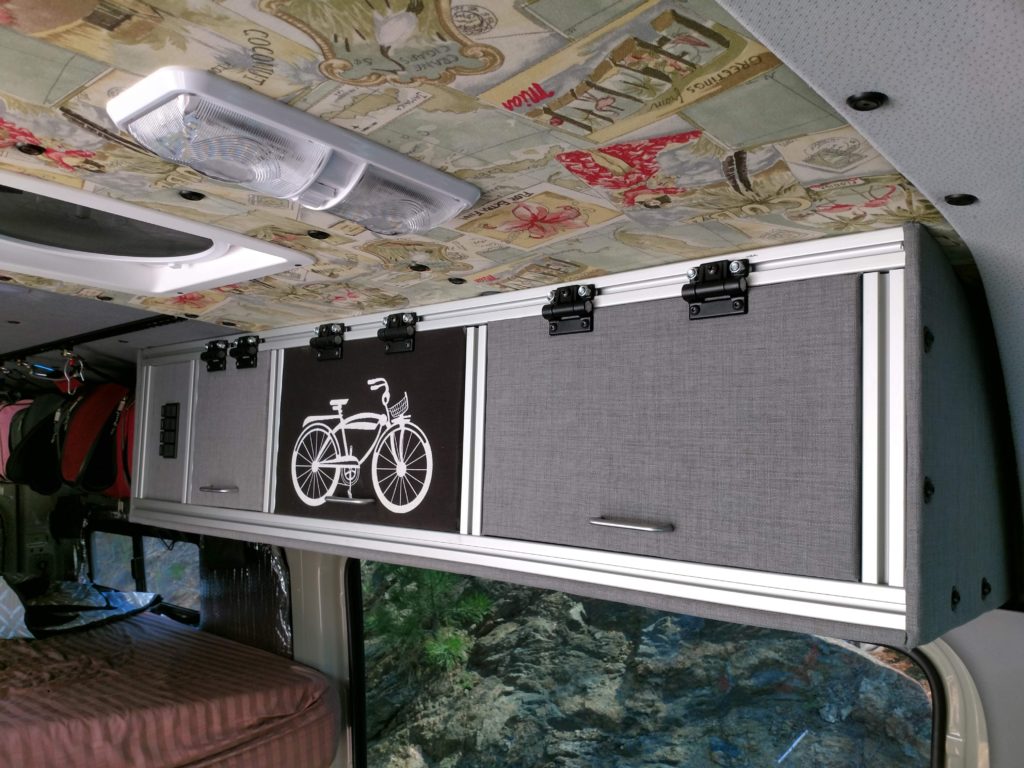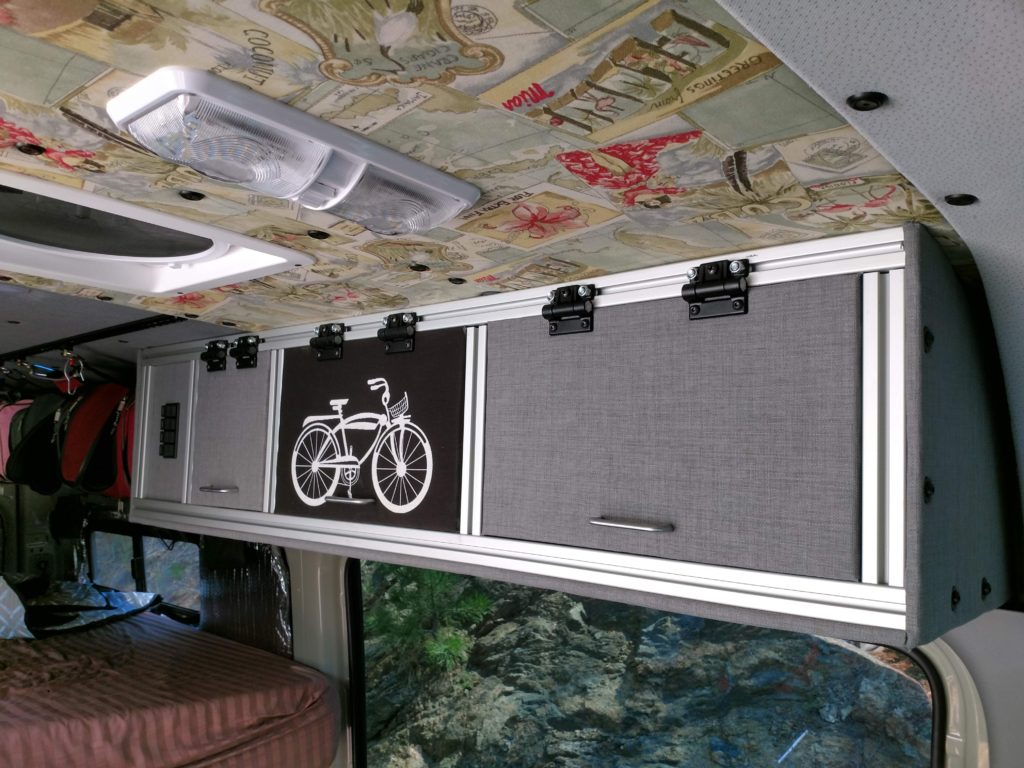
8020 Extruded Aluminum T-Slot cabinet
The majority of our Sprinter van build structure so far has been done with 3/4″ plywood and no 8020 aluminum extrusions. This has worked out pretty well. The upper cabinet for this latest project is a little different in that it has fewer attachment points to the van and does not touch the floor. I’d been researching different cabinet building materials in vans and kept coming back to folks that use extruded aluminum T-slot, due to the overall look and the strength to weight ratio. The main brand of T-slot extruded aluminum is 8020.
The major downside to 8020 is cost. The basic extrusions cost about 50¢ per inch and the connectors cost between $6 and $35 each. This adds up to a significant investment in materials. Shipping can be expensive considering the weight and some long lengths.
Some of the best resources for building with 8020 in a camper van include these:
8020 Tutorial in Sprinter Forum
The key info for me to be willing to use 8020 for this project is in the 2nd link above where Dave shows you exactly how to easily make your own connectors for just pennies a piece. This reduced my estimated cost of the project by about half.
During my research, one issue that came up repeatedly is how the 8020 company doesn’t care how much you spend on shipping and will not take the time optimize the packages for the materials you order from them to minimize shipping costs.
Other decisions with the 8020 extrusions include that there are many variants with how many sides of the extrusion has slots and whether the extrusions are square, rectangular or cornered. Using these different variants can improve the overall aesthetics of the cabinet. I chose to keep it simple and only use the square extrusions with slots on all 4 sides.
The extrusions can also be ordered pre-cut to length. Since my design is likely to change as the build progresses (typical software guy), I made all the cuts on-site from full length pieces.
I spoke with some local 8020 dealers and found one that was willing to help out with bulk pricing and optimized shipping. I placed the order with them and 2 weeks later a truck arrived at my door with a pallet containing about 300lbs of aluminum and no pallet jack in sight.
The packaging was very well done, there is not much chance of damage occurring.
8020 Connectors
Armed with the knowledge of how to make the connectors for the 8020, I sourced the aluminum flat bar and angle bar for the connectors from a local metal supplier. I used the miter saw with an aluminum cutting blade for making the bracket pieces from the bars. I splurged and got a Skil 10″ drill press for making the holes in the brackets since precision is important with the brackets to have a nice tight fit with the 8020 extrusions.
Based on the instructional links above, I ordered a good quantity of bolts, carriage bolts and nylon insert locknuts from McMaster Carr.
Assembly
After months of research and design and weeks of gathering materials, it is time to start building. The first steps are to mount the wall and ceiling braces. These are the only 2 pieces that will connect directly to the van. All other pieces will connect to these braces.
From this point, progress moves quickly for a while. The next part of the frame build out is basically like putting together an erector set. As long as the first two braces are parallel to each other, the rest should go smoothly. A key piece of the process here is that with each additional section of 8020 that is added to the structure, access to the t-slot of the existing structure is reduced. This means that you have to know where each carriage bolt and t-nut needs to be placed prior to blocking off a t-slot. Admittedly, I was only moderately successful at this and had to disassemble pieces more than once.
We added a power distribution sub-panel in the cabinet to make the switch locations more convenient for the interior lights and wifi. These Blue Sea switches are quite nice with a good tactile feel and an LED light indicator letting you know that the switch is on. We gave up a little space in the cabinet for this additional distribution panel, but the convenience seemed worthwhile. Prior to starting the cabinet, we ran the wires for the switches from the lower power distribution cabinet we built during the wifi project. These wires ran from that lower cabinet, behind the B-pillar cover and into the wall behind this new cabinet.
The doors were a bigger challenge having little experience in cabinet building. If there is a “right” way to attach doors to a cabinet like this, it is captured in this video. However, that method requires about $100 of hardware for each door and attention to detail that I might not have. I tried a couple of different door styles, sizes and hinge types and finally concluded with doors that are sized to fit within the cabinet frame using friction hinges. The friction hinges hold the door in whatever position you leave it in. They do look a bit bulky, but they do bolt nicely into the slots of the 8020 extrusions.
The door, bottom and side panels are all 3/8″ plywood wrapped in closed cell foam and outdoor patio furniture material. The fixed panels are through-bolted to T-nuts that are in the slots of the 8020 extrusion.
With some scrap plywood and material, we added an interior shelf to protect crushables like bread and tortilla chips.
Support our site by shopping on Amazon with this link at no cost to you
Materials & tools:
outdoor patio furniture material
(FYI…some links are Amazon affiliate links)
Support our website by shopping on Amazon with this link
